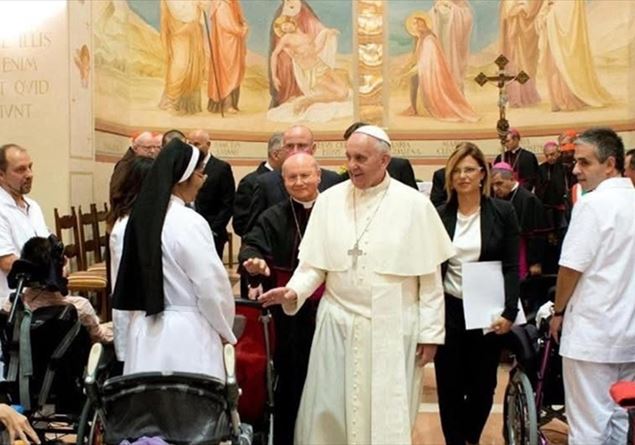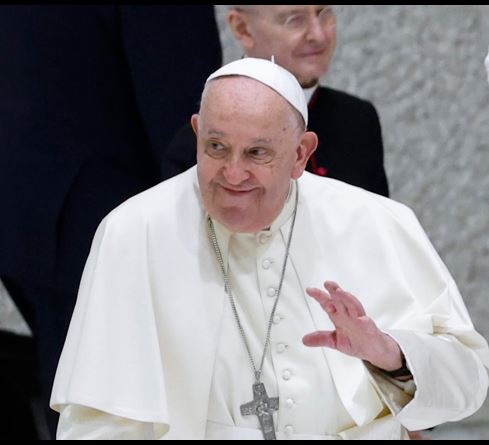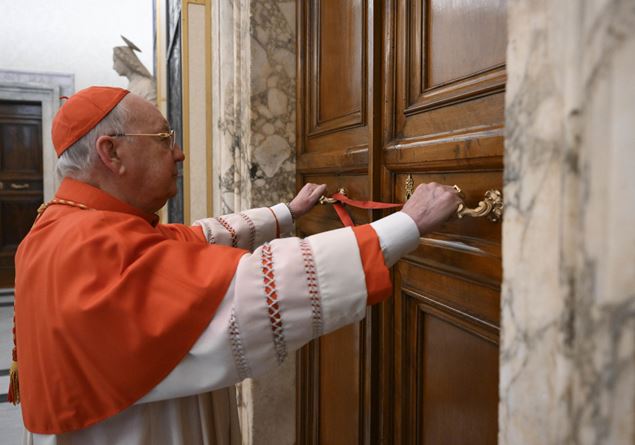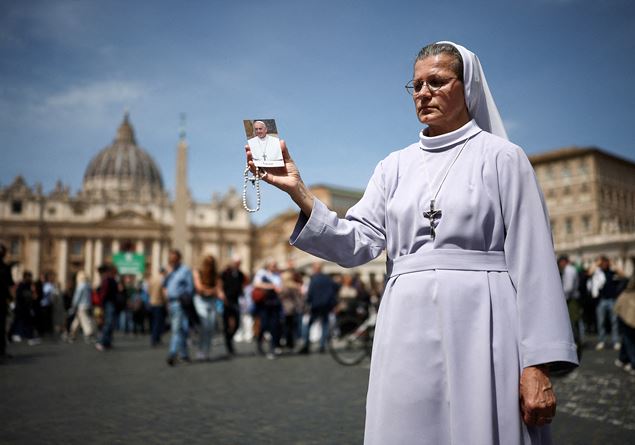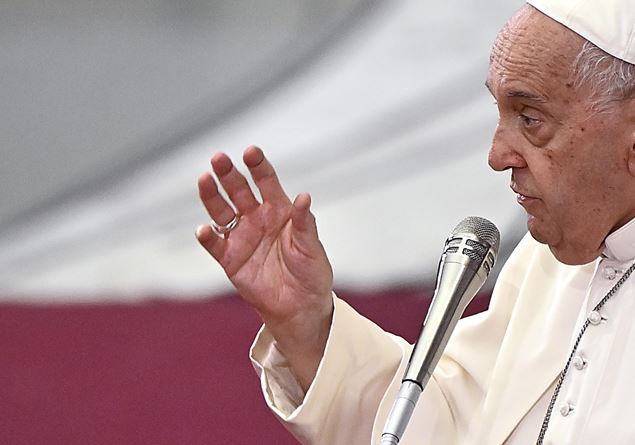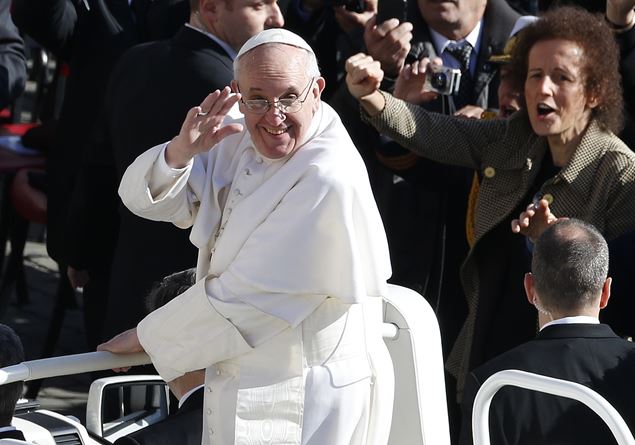There will not be the three coffins (of Cypress, Lead and Rovere), the official observation of the death will take place in the “home” of the deceased, the body will be exposed to the faithful for the tribute and the suffrage prayer no longer lying on a catafalco but inside the coffin that will be closed the evening before the day of the funeral.
These are some of the novelties of the pope’s funeral introduced by Francesco himself in theOrdo Exsequiarum Romani Pontificisis approved the April 29, 2024 To make the ceremonial more streamlined and sober and, above all, to emphasize that it is not the funeral of a “powerful of this world” but a shepherd and a disciple of Christ.
The first expected rite is the official observation of death. The body of Pope Francis will be brought to the chapel of the Santa Marta house, the residence of the pontiff, where at 8pm on Monday the observation of death by the Camerlengo, Cardinal Kevin Farrell, and in the presence of the dean of the Cardinal College, the Cardinal is carried out Giovanni Battista Re, Dand the family members of the Pope, the Director and the deputy director of the management of health and hygiene of the State of the Vatican city.
The update of the ritual of the funeral “was necessary”, as the Archbishop had explained to the Vatican media Diego Ravelli, Master of the Pontifical Liturgical Celebrations, “first of all because Pope Francis asked, as declared by himself on several occasions, to simplify and adapt some rites so that the celebration of the funeral of the Bishop of Rome better expressed the faith of the Church in the Risen Christ. The renewed rite also had to highlight even more than the funeral of the Roman Pontiff are those of a shepherd and disciple of Christ and not a powerful of this world».
In the interview book with Javier Martinez-Brocal El Sucesor (Planeta editions), released a year Fai, remembering the funeral of Benedict XVI, Pope Francis said: «It will be the last funeral vigil celebrated like this, with the body of the Pope exposed outside the coffin, on a catafalco. I spoke with the ceremonies and eliminated this and many other things. The current ritual was too overloaded ».
The three “stations”
Instead, the three classic “stations”, The one in the house of the deceased (Santa Marta, in this case), that in the Vatican Basilica and the place of the burial, the basilica of Santa Maria Maggiore, chosen by the Pope. “However,” as Archbishop Ravelli explained, “The internal structure of the stations and texts was revised in the light of the experience gained with the funeral of St. John Paul II and Benedict XVI, of the current theological and ecclesial sensitivity and recently renewed liturgical books ».
Among the most relevant innovations, to simplify pontifical titles: the terminology used in the third edition of the Missale Romanum (2008), that is the appellations of Dad, Of Episcopus and of Pastor, while in the general premises and in the columns it was opted for the expression Romanus pontifex, in accordance with the title of the liturgical book.
In the Italian translation, the lexicon used in the second edition of the rite of the funeral (2010) was taken up by the Italian Episcopal Conference, from which most of the terminology was updated in the Italian version of the rite, for example preferring the term coffin to indicate the body already closed in the coffin.
«The structure of the new Ordo»Added the master of the papal celebrations,”It has been simplified by reviewing or eliminating several ritual elements that are difficult to coordinate or deemed now inadequate. In addition, each ritual sequence has been made clearer and more precise, as well as the skills and roles of those involved in the preparation and carrying out of the rites have been better defined “.
The first station in the private chapel in Santa Marta
The first station takes place in the “house of the deceased” and provides for the novelties of the observation of death in his private chapel, rather than in the room, And the deposition of the body in the only wooden coffin and in the internal one of zinc, before being translated into the basilica. Therefore, the first translation in the Apostolic Palace was eliminated. Some passages were then better specified by remodeling the second station also: since the deposition in the coffin has already occurred after the observation of death, the evening before the funeral mass, it was built.
The second station in the Basilica of San Pietro
The second station “In the Vatican Basilica” considers a single translation in San Pietro (which will most likely take place on Wednesday 23), the closure of the coffin and the funeral mass. In the Vatican Basilica the body of the deceased Pope is exposed directly to the coffin and “no longer on a high cataletto”. Furthermore, in accordance with what the Caeremonial episcoporum For the funeral of the diocesan bishop, the papal pastoral pastoral will not be placed alongside the coffin.
The third station in the burial site
The third station, which includes the translation of the coffin and the burial, is that of the burial which, at the behest of the Pope, will not be in the Basilica of San Pietro, like many of its predecessors, but in that of Santa Maria Maggiore, Where he went to pray before and after every apostolic trip and where he went for the last time on April 12 to bring a bouquet of flowers and gather in prayer in front of the Roman Salus Populi icon. “This station,” explained Ravelli, “he suffered a significant streamlining due to the elimination of the deposition and closure of Cypress’s coffin in a second lead and in a third oak or other wood”.
Among other things, the Litanies of the saints, Sing during the rites of the funeral on two occasions: while the Pope’s body is translated into the Basilica, in the longest form, and during the traditional plea of the Church of Rome, at the end of the funeral mass, for which the short form was chosen.
The place of the burial, at the behest of the Pope, will not be in the Basilica of San Pietro, like many of its predecessors, but in that of Santa Maria Maggiore.
Francesco will be the first deceased pope to be buried outside the Vatican since 1903 when Leo XIII He was buried in the Basilica of San Giovanni in Laterano (where he rests with 21 other predecessors). In Santa Maria Maggiore, Francesco will be the eighth Pontiff to be buried after Honorius III (pontificate 1216-1227), Niccolò IV (1288-1292), Pio V (1566-1572), Sixtus V (1585-1590), Clement VIII (1592-1605), Paolo V (1605-1621) and Clemente IX (1667-169).
It will be up to the master of pontifical ceremonies, Diego Ravelli, establish the ways in which this translation will take place outside the Vatican walls.
The novedials
Concluded the funeral rite and burial that took place, For the universal church the solemn novedials will begin, that is nine days in which they will be celebrated put in suffrage for the deceased pontiff. In the expected liturgical ritual we pass from three to four the prayers of prayers of your choice, as all those offered by the Missale Romanum For the deceased Pope and that for the deceased diocesan bishop.
Unlike the previous edition, the texts of the ledger are omitted, of which only the biblical indications are offered.
The funeral are the first of the nine messes provided by the novediale, while for each of the other eight days the groups called to raise the suffrage prayer are indicated. The second day employees and faithful of the Vatican city, the third the church of Rome of which the Pope is the bishop, the fourth the chapters of the papal basilicas, the fifth the papal chapel; The sixth the Roman Curia, the seventh the oriental churches, the eighth the members of the institutes of consecrated life, and the ninth again the papal chapel.
The Cardinal College, from the moment of the Pope’s death, assumes the role of decision -making place and control cabin of times and methods in the execution of the rites. The general cardinals who can not participate in the conclave also participate in the general congregations.
It is always up to the Cardinal College to fix the date of the funeral and that of the beginning of the Conclave, which will see the celebration of the Mass in the morning Pro eligendo Romano pontifice, chaired by the dean of the Cardinal College. In the afternoon there will be the entry of the Cardinal Vlectors in the Sistine Chapel, the place of the Pope’s election. They will take an oath on the Bible and then the master of ceremonies will pronounce the Latin phrase “Extra Omnes”, that is, “all out”. Then the voting phases will begin.
